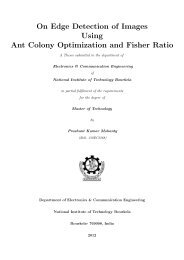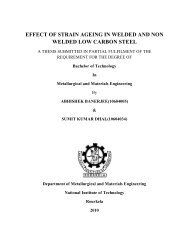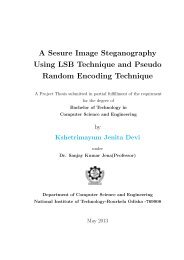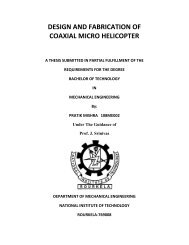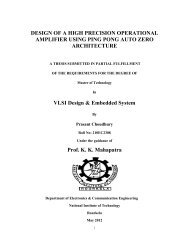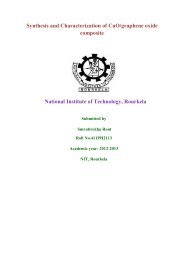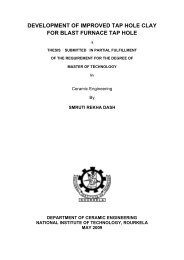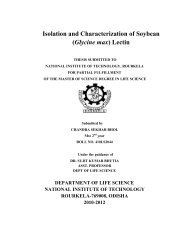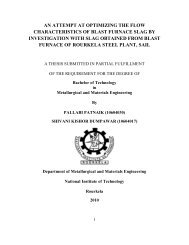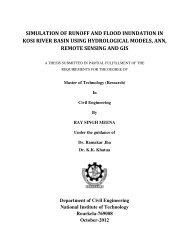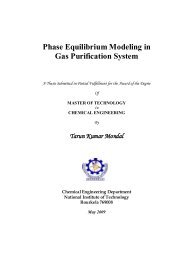Effect of hygrothermal treatment on the tensile properties - ethesis ...
Effect of hygrothermal treatment on the tensile properties - ethesis ...
Effect of hygrothermal treatment on the tensile properties - ethesis ...
Create successful ePaper yourself
Turn your PDF publications into a flip-book with our unique Google optimized e-Paper software.
fabric begin to fail from <strong>the</strong> centre <str<strong>on</strong>g>of</str<strong>on</strong>g> <strong>the</strong> fabric and propagate width-wise <strong>on</strong> ei<strong>the</strong>r<br />
side. The ultimate <strong>tensile</strong> strength and <strong>the</strong> tangent modulus <str<strong>on</strong>g>of</str<strong>on</strong>g> elasticity after initial<br />
stretching <str<strong>on</strong>g>of</str<strong>on</strong>g> <strong>the</strong> ‘as received’ jute fibre is found to be 120 MPa and 3.75 GPa;<br />
corresp<strong>on</strong>ding values for jute fabric are 85 MPa and 0.8 GPa. The variati<strong>on</strong> in <strong>the</strong><br />
values <str<strong>on</strong>g>of</str<strong>on</strong>g> strengths may be due to: (i) <strong>the</strong> assumpti<strong>on</strong> that <strong>the</strong> cross-secti<strong>on</strong>al area <str<strong>on</strong>g>of</str<strong>on</strong>g><br />
each yarn is circular, (ii) <strong>the</strong> difference in <strong>the</strong> strength <str<strong>on</strong>g>of</str<strong>on</strong>g> individual fibres in <strong>the</strong> fabric<br />
arising out <str<strong>on</strong>g>of</str<strong>on</strong>g> process defects.<br />
The <strong>tensile</strong> strength <str<strong>on</strong>g>of</str<strong>on</strong>g> a composite material is mainly dependent <strong>on</strong> <strong>the</strong> strength and<br />
modulus <str<strong>on</strong>g>of</str<strong>on</strong>g> fibres, <strong>the</strong> strength and chemical stability <str<strong>on</strong>g>of</str<strong>on</strong>g> <strong>the</strong> matrix and <strong>the</strong><br />
effectiveness<br />
<str<strong>on</strong>g>of</str<strong>on</strong>g> <strong>the</strong> b<strong>on</strong>ding strength between matrix and fibres in transferring stress across <strong>the</strong><br />
interface [10]. Fig. 2 shows <strong>the</strong> stress–strain diagram for four jute laminates and a<br />
polyester resin. The initial linear porti<strong>on</strong> <str<strong>on</strong>g>of</str<strong>on</strong>g> <strong>the</strong> jute laminate curves shows <strong>the</strong> elastic<br />
behaviour <str<strong>on</strong>g>of</str<strong>on</strong>g> <strong>the</strong> composite. The deviati<strong>on</strong> from linearity is an indicati<strong>on</strong> <str<strong>on</strong>g>of</str<strong>on</strong>g> <strong>the</strong><br />
beginning<br />
<str<strong>on</strong>g>of</str<strong>on</strong>g> initial matrix cracking, and <strong>the</strong> first major change in slope in <strong>the</strong> curve is <strong>the</strong> sign<br />
<str<strong>on</strong>g>of</str<strong>on</strong>g> a major crack in <strong>the</strong> matrix or <strong>the</strong> beginning <str<strong>on</strong>g>of</str<strong>on</strong>g> fibre failure. The first fibre failure<br />
occurs at a stress level <str<strong>on</strong>g>of</str<strong>on</strong>g> 26 MPa (approx.) and <strong>the</strong> corresp<strong>on</strong>ding resin stress is 5.5<br />
MPa for <strong>the</strong> same amount <str<strong>on</strong>g>of</str<strong>on</strong>g> strain. The rest <str<strong>on</strong>g>of</str<strong>on</strong>g> <strong>the</strong> drops in <strong>the</strong> curves are indicati<strong>on</strong>s<br />
<str<strong>on</strong>g>of</str<strong>on</strong>g> progressive failure <str<strong>on</strong>g>of</str<strong>on</strong>g> fibres as <strong>the</strong> applied load increases, and <strong>the</strong> end <str<strong>on</strong>g>of</str<strong>on</strong>g> <strong>the</strong> curve<br />
represents <strong>the</strong> ultimate stress which is due to fibre fracture and may be fibre pull-out.<br />
However, <strong>the</strong> failure mode exhibits breakage and little pull-out <str<strong>on</strong>g>of</str<strong>on</strong>g> fibres. The average<br />
values <str<strong>on</strong>g>of</str<strong>on</strong>g> ultimate <strong>tensile</strong> strength, initial tangent modulus and Poiss<strong>on</strong>’s ratio for<br />
<strong>the</strong>se composites are 60 MPa, 7 GPa and 0.257, respectively, and corresp<strong>on</strong>ding<br />
values for polyester resin are 12.1 MPa, 1.4 GPa and 0.38. The values obtained by <strong>the</strong><br />
rule <str<strong>on</strong>g>of</str<strong>on</strong>g> mixture are 63 MPa and 1.12 GPa. The difference in <strong>the</strong> initial tangent<br />
modulus obtained from experiment and rule <str<strong>on</strong>g>of</str<strong>on</strong>g> mixture is due to initial stretching and<br />
<strong>the</strong> nature <str<strong>on</strong>g>of</str<strong>on</strong>g> <strong>the</strong> fibres.<br />
16





